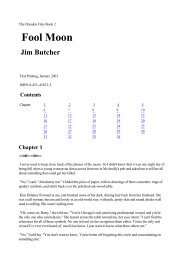Monster Geographica - Marsh & Aquatic.pdf - The Secrets of the ...
Monster Geographica - Marsh & Aquatic.pdf - The Secrets of the ...
Monster Geographica - Marsh & Aquatic.pdf - The Secrets of the ...
Create successful ePaper yourself
Turn your PDF publications into a flip-book with our unique Google optimized e-Paper software.
2<br />
Skin Wraith<br />
Medium Undead<br />
Hit Dice: 3d12 (19 hp)<br />
Initiative: +4<br />
Speed: 5 ft. (1 square), fly 30 ft. (average)<br />
(6 squares)<br />
Armor Class: 15 (+4 Dex, +1 natural),<br />
touch 14, flat-footed 11<br />
Base Attack/Grapple: +1/+6<br />
Attack: Lash +5 melee (1d4+1)<br />
Full Attack: 3 lashes +5 melee (1d4+1)<br />
Space/Reach: 5 ft./5 ft.<br />
Special Attacks: Envelop 1d6+1, improved<br />
grab<br />
Special Qualities: Damage reduction<br />
15/piercing or slashing, darkvision 60 ft.,<br />
undead traits<br />
Skinwraiths are <strong>the</strong> remains <strong>of</strong> torture<br />
victims flayed alive on <strong>the</strong> rack, animated by<br />
<strong>the</strong>ir own pain and suffering. <strong>The</strong>y appear as<br />
sheets <strong>of</strong> human skin flying along <strong>the</strong> ground,<br />
moaning s<strong>of</strong>tly in pain and self-pity. Skinwraiths<br />
flit about <strong>the</strong> landscape, hunting for signs <strong>of</strong> life.<br />
If <strong>the</strong>y sense a living creature nearby, <strong>the</strong>y fly at<br />
high speeds toward it, intent on smo<strong>the</strong>ring its<br />
life away. Skinwraiths are most <strong>of</strong>ten found near<br />
ancient torture chambers or abandoned prisons<br />
wherein captives were skinned alive.<br />
Combat<br />
A skinwraith attacks by smo<strong>the</strong>ring and<br />
enveloping its target, keeping o<strong>the</strong>r opponents at<br />
bay by lashing at <strong>the</strong>m viciously with long strips<br />
<strong>of</strong> flayed skin.<br />
Envelop (Ex): A skinwraith can wrap around<br />
its foe completely. With a successful grapple check,<br />
<strong>the</strong> skinwraith pins its opponent and deals 1d6+1<br />
points <strong>of</strong> bludgeoning damage. While its opponent<br />
is pinned, any attacks striking <strong>the</strong> skinwraith deal<br />
36<br />
Saves: Fort +1, Ref +5, Will +1<br />
Abilities: Str 12, Dex 18, Con —, Int 3, Wis<br />
6, Cha 11<br />
Skills: Hide +5, Listen +2, Move Silently<br />
+5, Spot +2<br />
Feats: Alertness, Weapon Finesse<br />
Environment: Any<br />
Organization: Solitary or haunt (4-7)<br />
Challenge Rating: 2<br />
Treasure: None<br />
Alignment: Always neutral evil<br />
Advancement: 4-6 HD (Medium); 7-9 HD<br />
(Large)<br />
Level Adjustment: —<br />
damage to both <strong>the</strong> skinwraith and its victim; each<br />
receives half <strong>the</strong> damage before damage reduction,<br />
rounded down.<br />
Improved Grab (Ex): To use this ability, a<br />
skinwraith must hit a Large or smaller opponent<br />
with its lash attack. It can <strong>the</strong>n attempt to start<br />
a grapple as a free action without provoking an<br />
attack <strong>of</strong> opportunity. If it gets a hold, it can<br />
envelop its foe. A skinwraith has a +4 racial bonus<br />
on grapple checks.<br />
Campaign<br />
Due to <strong>the</strong>ir unusual shape and consistency,<br />
skinwraiths can be placed in many places o<strong>the</strong>r<br />
monsters or undead cannot reside. In fact,<br />
skinwraiths can be encountered in almost any<br />
setting, even underwater or high in <strong>the</strong> air.<br />
Skinwraiths also combine easily with traps, as<br />
<strong>the</strong>y can be folded up and placed in small confined<br />
spaces. <strong>The</strong>y may be placed in treasure chests or<br />
in sacks as well: always a fun way to surprise <strong>the</strong><br />
party.<br />
Flora and Fauna<br />
Gas Hydrates: Undersea deposits <strong>of</strong> solid methane. Methane is usually a gas, but becomes solid<br />
under enormous pressures found on <strong>the</strong> deep sea floor. When a piece <strong>of</strong> methane breaks <strong>of</strong>f, it returns to<br />
its gaseous state, expanding into a giant bubble. <strong>The</strong> methane bubble erupts upon reaching <strong>the</strong> surface,<br />
which scientists speculate as a possible cause <strong>of</strong> spontaneous sinking <strong>of</strong> ships. If ships are far away from<br />
<strong>the</strong> bubble or exactly on top <strong>of</strong> <strong>the</strong> bubble, <strong>the</strong>y are fine. But if ships are in <strong>the</strong> area between <strong>the</strong> stagnation<br />
point and <strong>the</strong> edge <strong>of</strong> <strong>the</strong> mound, it’s sinking fast because enough water does not support part <strong>of</strong> <strong>the</strong> ship.<br />
Scientists are not sure how large <strong>the</strong>se bubbles can get.







